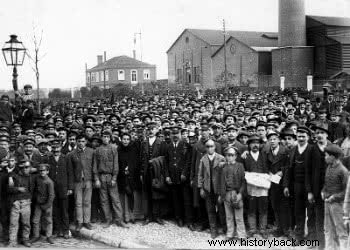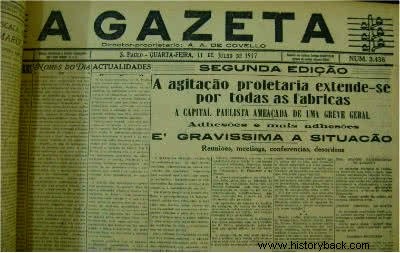The General Strike of 1917 was a movement provoked by the workers and merchants of São Paulo in the months of June and July.
Workers asked for better working conditions and salary increases. After five days of general strikes, the strikers had their demands met.

Aspect of a factory in São Paulo in the 10's.
Historical Context
At the end of the 19th century, with the Second Industrial Revolution, the working class of countries like England, Spain and Germany, organized themselves to pressure the bosses to guarantee decent working conditions.
However, problems were not always resolved peacefully. As an example we have the Tragic Week in Barcelona, 1909, when striking workers were massacred by the government.
In 1917, the world was experiencing the First World War that was wreaking economic and social damage in European countries. Likewise, he watched the seizure of power by socialists and communists in Russia.
In turn, Brazil was experiencing a period of economic instability caused by food shortages and, consequently, inflation.
The first factories in Brazil began to open, attracting peasants who sought better opportunities for salary and life in the city. Working conditions in these factories were the worst possible. There was no labor legislation, working hours lasted up to 16 hours a day, women and children performed heavy work and labor issues were resolved with the police.
Read more about Feminism in Brazil.
Organization of the Workers' Movement in Brazil
Workers, in the First Republic, were organized into state unions.
The only entity at the national level was the Brazilian Workers' Confederation founded in 1906, on the initiative of the unions of Rio de Janeiro, São Paulo, Rio Grande do Sul, Pernambuco and Bahia.
There were also the “Mutual Relief Societies” and “Benefit Banks” that had a social character. These institutions guaranteed medical assistance and compensation for accidents at work to their members.
The scenario changed when Italian and Spanish immigrants, who came to work in São Paulo's factories, began to spread anarchist and socialist principles through workers' newspapers.
In them, they called attention to the need to organize and mobilize workers in order to achieve labor rights.

Cover of the newspaper A Gazeta of July 9, 1917 announcing the strike.
The Strike Starts
The strike began at the Crespi factory, which employed 2000 workers, in the Moca district. The workers asked for a raise in wages, a reduction in working hours, a ban on child labor and women's work at night.
This movement spreads to other factories in the neighborhood, causing the adhesion of more workers. Inspired by the anarchist ideas disseminated by journalist Edgar Leuenroth, workers hold the first rallies in neighborhoods and public squares.
Throughout the month of June, several factories join the strike. On July 8, the Strike Committee was created, proposed by the anarchists. The next day, the police kill the Spanish shoemaker José Martinez and cause a riot among the strikers.
On July 12, the strike was declared. São Paulo dawns with factories, shops and transport stopped. Faced with strong police repression, the workers refuse to negotiate directly with the bosses and journalists are in charge of forming an intermediary commission.
After arduous negotiations, the workers won a 20% salary increase, the right of association and the non-dismissal of those involved in the strike. On July 16, a rally held in Largo da Concórdia, decreed the end of the first general strike in Brazil.
Consequences
The General Strike of 1917 left its mark among Brazilian urban workers. In this way, we can quote:
- Brazilian workers acquire class consciousness;
- the first unions were developed from the neighborhood class leagues;
- spreading and strengthening leftist ideas in Brazil;
- Social conflict resolution should not be resolved through the police.
